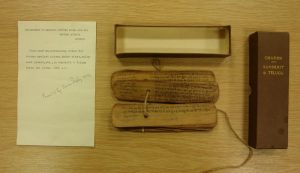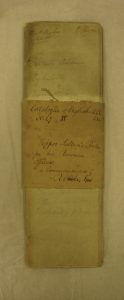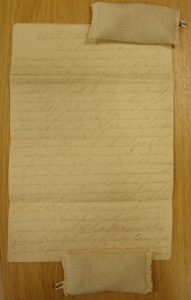Miscellaneous Box M
At the recent South Asian Archives and Library Group (SAALG) Annual Conference, I was asked to give a talk on some aspect of our Collections. The general theme of the conference was on ephemera, so I chose to delve into one of our, as yet, unsorted boxes, to discover whether the material within it, was of core importance to the Collections or more ephemeral in nature. At the beginning of 2017, I had decided it was time to begin preparing our Institutional Archives ready for cataloguing. Records from an institution should be organised according to the functions that produce the records. So I have begun re-organising the records into categories such as Membership, Collections, Publications, Lectures and Events, Property, etc. ready for further organising for cataloguing. As part of this, I need to assign all the material in our boxes into these categories or identify them as Personal Papers or Special Collections. For the talk I decided to tackle Miscellaneous Box M .

This is the first item that I took from the box:

On 15 March 1834, Charles Joseph Doyle gave to the RAS “An extensive and most valuable collection of printed books, Oriental manuscripts, original maps, plans, surveys, and drawings”. This donation included a beautifully illustrated version of the Shahnamah of Firdausi, the epic Persian poem. This is currently at Cambridge University Library and has recently been digitised. In the Journal list of all the donations from 7 December 1833 to 19 July 1834, Doyle’s gift contributes a significant portion, and, after recording all the printed books, manuscripts and artworks, the penultimate sentence states:
“A Collection of original Maps, Plans, Routes, &C. chiefly in MS, illustrative of India, Russia &c. amounting to nearly one hundred and forty.”
140 maps! (Or 173 if you read some other documents.) Unfortunately. our map collection is still dependent on its card index, so it is not easy for me to quickly trace which ones might have come into the Society from Doyle. But this first item in the box is one that definitely did. Housed in a marbled cardboard box-folder, this Plan of Moscow, has been conveniently labelled in ink on its canvas reverse:
“Presented to the Royal Asiatic Society by Lt. Col. C J Doyle, 15th of March 1834”.
The Plan itself is 106cm by 100cm, with labels in both Russian and French and whoever first drew it must have been a competent draughtsman and something of an artist.
But who was Doyle and why did he donate this Plan of Moscow and many other Russian items to the Royal Asiatic Society? And since most of those other Russian items are no longer part of the Collections, is it appropriate to keep this one?
Charles Joseph Doyle, commonly called Caro Doyle, was born in Warsaw in 1787, the second son of Welbore Ellis Doyle who was a Military Envoy stationed in Warsaw at that time. Doyle joined the army as a 16-year-old in 1803 and went to Bremen and Hanover. In 1807 he was appointed a Captain, serving in Guernsey and in 1808 in north of Spain. He continued to serve in Europe until 1813 when he was appointed Military Secretary to the first Marquis of Hastings, Governor-General of India. Doyle took part in the first Nepal War and was then recalled to Cawnpore. When peace was made with Nepal in 1815, he was despatched on an expedition to Java.
Doyle returned to Calcutta in 1816 and the following year was involved in the operations with Lord Hastings including the surrender of Poona. Doyle resigned in 1821 and left India sometime after that. He travelled overland visiting Persia, Turkey, Russia and Poland – so it is presumably at this stage that he collected the Plan of Moscow. He arrived In England in time to become one of the Founding Members of the Asiatic Society of London, first attending a meeting on 15 February 1823, when the Society was still in its planning stages and becoming one of the original Council Members on its inauguration. He continued to serve on the Council and was instrumental in setting up the Committee of Correspondence to represent the views of the Society to persons residing in different parts of the globe.
Doyle had left his assets in a bank in Calcutta but when this failed, he took up the post of Private Secretary to Lord Sligo in Jamaica. An early biography of Doyle by his nephew Arthur Doyle suggests this was in 1827. However, the minutes of the RAS might suggest otherwise. Doyle was an active member of the Council beyond this date and in the Minutes for the Council on 15 March 1834, along with the donation, Doyle hands in his resignation for the offices held by him in the Society as he was about to leave England.
Perhaps his departure, even then, was not so imminent. There is evidence in The National Archives that Doyle requested to become Lieutenant Governor of Grenada in 1836 whilst still in London and it appears he held the role twice from 1836-1841, and again from 1841-1845 after a short furlough. He then returned to England and was made a Major-General. He died in 1848 at his house in Regent Street London.
He remained a member of the RAS until his death but appears not to have taken any further active part. Sad to say there appears to be no obituary for him in the Journal.
So that answers the first question about why we have the Map of Moscow. What about the second? Should we keep it or find a home for it somewhere else? This is a difficult question that could be debated for hours in the Library Committee meetings. For me, Doyle was an important part of the origins of the Society and though Russia is not really part of our remit, this map could become either become part of the map collection when we tackle cataloguing it or become part of Doyle’s Personal Papers. As I am gradually sorting through the archives I hope to find other things that belonged to him, which in time I could collate to make his Personal Papers. For the time being this plan of Moscow is listed as one of our Special Collections.
The second item is “Charms: Sanskrit and Telugu”:

Here we are perhaps on more solid ground in terms of appropriateness of Collections. The manuscript fortunately comes with a descriptive label:
“Palm-leaf ms. Containing rules for charms against poison, snake-bites, malignant powers, etc., in Sanskrit & Telugu verse and prose. 1825 AD. Presented by Simon Digby, 1972.”
The Council Minutes for 10 February 1972, report:
“Noted with pleasure Mr S.E. Digby’s presentation of palm leaf manuscripts to the Society”.
And the Report of the Council for 1972 for the Anniversary General Meeting, 10 May 1973, in the list of donations states:
“Printed books, and four palm-leaf Indian and Sinhalese MSS from Mr Simon Digby”
So this is one of four, the other three, I have yet to locate. But what should I do with this one? For its care: The label was humidified, so it could be flattened and cleaned, and both the label and boxed MS were housed in an archival quality envelope. Then the MS can be added to the South Indian Mss Collection.
Simon Digby was born in India in 1932, his father being an Indian High Court Judge and his mother a painter. Within the Archives we have a photocopy of Digby’s Obituary from The Times, 27 January 2010, and it is from this that I learnt something about his life. The byline claims he was a “Scholar, writer, linguist and collector whose life was shaped by his enduring love of India” and in reading the obituary that certainly seems to be true. Simon Digby not only spent time in India but worked with Cambridge University, SOAS and the Ashmolean Museum, and with the Royal Asiatic Society. He was Honorary Librarian of the RAS from 1969 to 1985 and his work with the Collections can be seen in many labels that he has added to items, and some correspondence that we hold. He also helped edit “The Royal Asiatic Society: Its History and Treasures” produced for the 150th anniversary of the RAS in 1973 which includes a chapter written by him on one of our Shah-nama manuscripts in Mughal Style. In 1999 the RAS awarded him the Burton Medal and he delivered a paper, later published as “Richard Burton: the Indian Making of an Arabist”.
The next item I retrieved from the box was also a manuscript, but a very different one.

It is “Tippoo Sultan’s Rules for his Revenue Officials” which according to the label was communicated to the RAS by Richard Clarke. Clarke was a senior member of the Board of Superintendence at Fort St. George, a Member of the Board of Revenue, and a Tamil translator to the Government. He left India in 1825. He became a member of the RAS on 18 November 1826, and was, in time, both Secretary and Treasurer of the RAS.
Our early donations of English Manuscripts have their own handwritten catalogue in a beautifully bound ledger and this manuscript is listed in Section IV for Political, Statistical. Commercial, etc. which states:
“This paper is a Code established by Tippoo in the direction of his Revenue Officers. It contains minute details on the nature of the produce to be grown on the soil, and on the mode of cultivation; the best mode of encouraging the industry of the Ryots, for preventing waste and rules for carrying of works on the lands such as [Tawks], embankments, etc. Valuable notes are appended by the Translator.”
And the translator is Ram Raz. And once I’ve humidified and flattened the document so that I can actually read it I found a heading agreeing that it had been translated by Ram Raz and indeed there were additional notes made by him.

Ram Raz is known for his “Essay on the Architecture of the Hindus” which was published posthumously by the RAS in 1834 and for which we hold a fantastic collection of architectural drawings. But on looking at the book I discovered that the preface was written by Richard Clarke. It seems that Clarke met Ram Raz whilst at Fort St George. Ram Raz, born to a poor family, mastered English serving as a clerk in the office of the English Military Auditor. As his abilities became known, he was first appointed head English master at the College of Fort St. George. Later he was appointed to the position of Judge and Magistrate in the Mysore state. I will not go into the discussion as to how much the English influenced the slant of the text of the Essay. However, within the Archives we have a partial handwritten manuscript of the book.
I compared the two and the handwriting was very different – was either of them written by Ram Raz – one or either of them copied? I went on a hunt in the Architectural Drawings and was fortunate to find a handwritten list in the first box I opened. The handwriting of the list was remarkably similar to that of this Tippoo Sultan document – so I would surmise, though cannot be sure, that this is the handwriting of Ram Raz. Or is it that they are both in the writing of Richard Clarke or some other scribe – more research needed…
Where to house the MS? I have found several of these English Manuscripts. which for now are going into Special Collections and subsequently will, I think, be housed and catalogued together. But this one presents something of a dilemma – with the manuscript for the Essay on Architecture and the list within the Architectural Drawings and what other material may yet come to light, should I create the Personal Papers of Ram Raz? This might then give these Papers more prominence than if they are just part of the RAS Institutional Archives.
So already three very different items. all of which present challenges as to their care and cataloguing. There are more items within the box but I will wait for future blog posts to reveal more…
